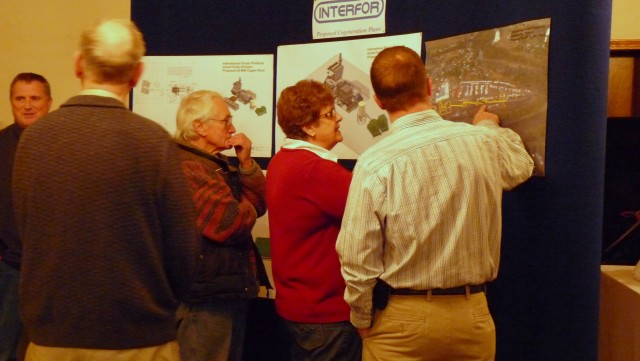Interfor previews new energy facility for Grand Forks
A proposal for a co-generation plant was unveiled on Monday in Grand Forks. For most of the city this was the first look at the power plant project that International Forest Products Ltd. (Interfor) is interested in building on their sawmill site. The 20 megawatt plant will deliver power and provide benefits to the company’s existing operations. Key questions that arose at the information session focused on concern for the environmental impacts of the plant.
General Manager Andrew Horahan was on hand to talk with local residents about the proposal. With potential for 14 new permanent jobs on the mill site, and 12 jobs in the woods, Horahan promoted the plant as an important economic opportunity generating $2.7 million in local activity annually. Paired with a reduced carbon footprint for the mill operation, Horahan sees the new plant as winning model. “People are here to find out: what the heck are you building,” said Horahan as a steady stream of people perused the open house on Oct. 25 at the Omega Restaurant. “We’re still in our preliminary stages of working with the ministry of environment on exactly the emissions from these plants, although on the noise front the co-gen facility will be quieter than the sawmill is. I think tonight is mostly about understanding what Interfor’s thinking of doing, and where are they at in the process.” Craig Carlyle, energy manager for Interfor, was on hand to provide details about the plant’s operation. The facility will be similar to one they already operate in Adams Lake. Fuelling the plant with mill waste (bark, sawdust, and shavings) along with logging slash, the project will create both heat and power from their process. The steam will be used by the kilns for drying wood, eliminating the need for gas, and the power generated will be sold to BC Hydro through FortisBC’s lines. Questions about the noise levels, visual appearance, emissions and water use were all voiced by residents. All of these concerns were addressed at the open house. The plant will be built on the north side of their property behind the berm facing the Kettle River. The only visible item will be a 98 foot high stack. The plant will comply with existing noise ordinances, and is suggested to be less than the current noise levels of the mill. “I think (the water use) is a concern,” said Horahan. “We’ve looked at various options on supplying the plant with water ranging from approaching the city to have discussions about using the city well system to using our own well system, and we’re still exploring all our options.” Two systems will collect 99 percent of particulate from possible air emissions. Ash, a by-product of the process, will be used as fertilizer and possibly exchanged with the landfill for wood fuel. Water use will be about 250 gallons per minute and will mostly evaporate, except for up to 45 gallons per minute which will be discharged into the sewer system if not used on site. The real environmental benefit, said Carlyle, comes from the overall reduction of trucking. “The net effect here of tracker-trailers is less too because now we haul all our residuals off-site,” explained Carlyle. “We haul 85,000 bone-dry tonnes a year off the site. Now we’ll be trucking in 50,000 so the net gain of 35,000 not hauled. That’s 2500 less trucks as well as all that natural gas that we won’t be burning. We want to increase the value of our residuals, get off natural gas and supply it with a lower cost fuel.” Grand Forks City Council has had a couple of opportunities to discuss the plant with the company. Councillors Chris Moslin, Gene Robert, and Christine Thompson all expressed their support the plant. All indicated that the company has been diligent in addressing their concerns, particularly around the environmental impacts. “I’m very impressed. I think that the carbon offsets that they’re going to be generating, the fact that they’re going to be bringing in materials from where they’re logging is going to be a huge benefit,” said Thompson. “Of course one the concerns is the particulate matter in the emissions and what’s in them. At this point in time they don’t have the answers because they haven’t run the tests. But I understand it will be well below the permitted amount. I think it’s a very positive step for the community and one that I’m fully behind.” While the planning is in an early phase, explained Horahan, the company is moving forward with an application to sell power to BC Hydro. The application must be received by the end of the month. From that point it may be months until Interfor knows if they have been accepted. In the meantime, plans for building a new sawmill are not contingent on the co-gen plant moving forward, although Horahan said it would certainly make the mill project more viable over the long-haul.























